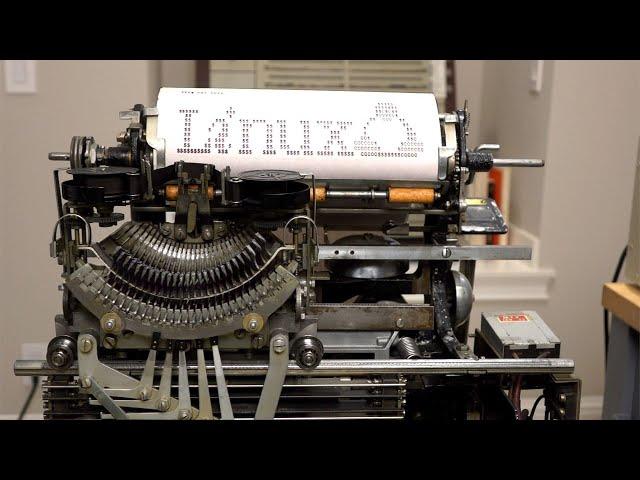
Using a 1930 Teletype as a Linux Terminal
Комментарии:

Amazing... essencially the first fax machines...
Ответить
Everyone should have a teletype at home. A much more convenient way to communicate with each other. Until advertisers started spamming everyone's home system with reams of nonsense.
Ответить
Gotta love the wooden roller guides...
I don't understand much of the technical aspects of this project; however I fully appreciate the absurdity of it!

it's amazing!
Ответить
Next, they're doing Linux on a potato.
Ответить
echo -n | sudo tee /etc/motd
Bye bye disclaimer

Thật tuyệt vời! Một cổ máy phức tạp được kết hợp từ cơ khí, điện tử, vi tính. Làm cách nào mà họ có thể tạo ra nó trong những năm 1930?
Ответить
SteamPunk
Ответить
Wow, kudos!!!
Ответить
now run neofetch
Ответить
abs nuts bro
Ответить
Here I'm again two years later, just to add a very interesting thing I learned today: when Linux Torvalds was writing the Linux kernel for the first time, he was initially actually trying to write, in his just purchased x86 computer, a terminal "emulator" to connect to his university’s larger computers. The "real" terminals were the electro-mechanical, big piece of iron, typing machines, known as teletypewriters at the times.
Ответить
That teletype was what graphic cards evolved from.😀
Ответить
Damn. I've never subscribed to a channel harder than this.
Ответить
this looks perfect for those that are paranoid about the government spying on them.
Ответить
I use ALIOTH ALPHA AI. rev 2080. Was integrated in me at year 12, me was born in 2071
Funny to look at these 1930 version.

Holy cow, that is the most steampunk thing I've ever seen! I've never seen Linux sh prompt printed on paper in realtime! Very nice!! :D
Ответить
Would have loved this when I had My Amiga ; ) Would this have been easy to capture the data externally for spying etc, hence the need for encryption. How did they send the data from submarine in wwii because im sure ive seen them surface and use something similar. Im not up on all this radio and teletype stuff. wish I had seen a video like this 30 years ago would have sparked my interest
Ответить
Neofetch!!!
Ответить
The C preprocessor has some special codes, going back to ancient times, to represent characters you might not have on your keyboard...
\LBR: Represents the left bracket character ([).
\RBR: Represents the right bracket character (]).
\LCB: Represents the left curly brace character ({).
\RCB: Represents the right curly brace character (}).
\LPN: Represents the left parenthesis character (().
\RPN: Represents the right parenthesis character ()).
There are more, that's just a selection that a useful robot friend told me. Of course they require backslash. You might want to implement that in your Arduino translator, using the blank key and some other key. You might even copy the MS-DOS feature where you can hold down ALT and type some numbers for an ASCII character. Of course you would have to dedicate an ALT key. But the blank key inspires optimism! Press that then some other key, limited to numbers maybe or useful mnemonic letters, to include just some basic symbols. Just backslash is a huge start, and you can even use 92 as it's ASCII code.
In my opinion this project isn't finished until it's as practical as possible! Having the Arduino in the loop makes a huge difference, imagine implementing all this with cogs and levers! Imagine a serial to parallel convertor made of levers! And back again! But not at 45 baud cos that's too slow, but not 46 cos that'd be way too fast.
Presumably the baud rate depends on the motor running in sync with the 60Hz mains. Which sometimes runs slower under heavy load when the generators don't spin quite as freely, so then they speed it up later on in the day to compensate, so a day always has whatever 60Hz x 24 hours is. All for the sake of a few old wall clocks that are synced to the mains. When two teletypes send messges over a distance, it would help a lot if they were on the same mains circuit, the same area of the country. Although I suppose all of the country is on the same grid, it would be in the UK at 50Hz. If parts of the grid were out of sync there'd be huge explosions, or if they were just a little bit out of sync, some generators would back-drive the others. Actually it might not matter if you try running at 50 baud, it's only mechanical. You'd need an inverter to test that, with a variable frequency, which they don't usually have. Maybe get one you can set to 50Hz and use the 60Hz mains for another, and hope it doesn't blow up. Put a decent fuse on the data line and maybe opto-isolate them.
Sorry why would anyone do that? Just a thought experiment, don't bother buying expensive stuff then blowing it up cos I'm having a brainwave. Sorry. Sorry.

i wanna try and make this with the faster electronic typewriters
Ответить
You should pair radio hardware with your linux system then, with it then send a radio message with your model 15. You will have ascended to next level
Ответить
ENQUBIASELETRIKJASS!
Ответить
plug chatgpt to it )
Ответить
Amazing. I think you might be able to use tri-graph codes to get around not having all the characters for programming at least in C, although having just googled it needs at least a "keyboard" that supports ISO646 character set😮
Ответить
This type of Teletype machines was often converted to the TDD (Telecommunication Device for the Deaf) machines for the deaf people in the 1960s and 1970s before the digital version was introduced in the late 1970s. They were very cheap and readily available, yet the deaf people had to buy the special modems that worked with the teletype machines.
Since I am deaf, the clattering noise didn't bother me but did to my hearing parents. So, my father moved the machine to the specially built soundproofed room in the basement. I miss the distinctive smell of lubricating grease and ink ribbons wafting from the machine after the mechanism warmed up.

KOMPLIMENTE 👍
Ответить
Hahah dieselpunk computer
Ответить
Think! When that teletype was first in service, nobody had the slightest clue what that tall pointy thing with USA written on it's side was!
Ответить
When we were taught the history of computers back at school in the 1980s, we went straight from Holerith to ENIAC... I think things would have flowed better AND made more sense if we'd stopped-off at the Teletype in between.
Ответить
Can some degree teach a person how to design this? I think innate talent is more important.
Ответить
This is nothing different than any other Linux experience lol
Ответить
Merci beaucoup monsieur, pour cette publication : vous n'imaginez pas le nombre d'ingénieur à qui je demande :"alors, qui sait ce que signifie 'tty', lorsque nous utilisons un système d'exploitation de la famille POSIX ?"
Ответить
Electroboom FULL BRIDGE RECTIFIER 😆 👏 👏 👏
Ответить
Sudo apt-get update "5 days later"
Ответить
oh, this is a cool circuit, it has a FUULL BRIDGE RECTIFIER
Ответить
Some ham radio guys still run these old machines. There is also free ham radio software online that can talk to it. Nice job.
Ответить
You can probably write fortran 77 using ed
Ответить
C'est absolument génial d'avoir réussi à connecter une machine de 1930 sur un ordinateur de notre époque tournant sur Linux. Passionnant et brillant. Bravo ! 😃
Ответить
"Yoooooo did you heard that? John from the Computer Room can draw the Roadrunner on paper using the machine!"
"I can't believe you, that's impossible!"

Вот ты меня поразил реанимировать телетайп 1930-го года!
Я в жизни ничего подобного не видел!!!
Код Бодо я только в энциклопедии встречал

Wow. So you can just print out all terminal outputs. Awesome! 😊
Ответить
Amazing
Ответить
So awesome!
Ответить
Мужик, это было очень круто!
Ответить
Amazing! I thought I was the only one crazy enough to do this.
Back in the late 60 s I put together a ham teletype station. It predated home computers. So when I got my Commodore Pet computer in 1977, I decided to use that model 15 as my printer. After a winter of effort, I devised a very good solution. With a simple handshake interface, and using the 2nd cassette buffer memory I came up with a machine language program that would read an ASCII character output on the IEEE port (by reading memory) it would convert it to 5 bit baudot and send it serially out a user port bit which keyed the teletypes current loop. For the pets special cursor movement characters it printed 2letter abbreviations like HC for home cursor. It also handled the upper/lower case shift issue correctly as well as printing return before line feed so that the print head had more time to get to home position before having to print another character. It was a difficult project since I had only 288 bytes of space and I had to hand assemble it since I had no assembler.
I still have that pet computer and the software. I passed on the teletype years ago. It would be cool to resurrect that setup if I could only find a baudot teletype. Congratulations on your efforts to keep that old teletype going!

FULL BRIDGE RECTIFIER! hahahhahahahahaha <3
Ответить

























